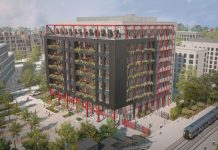Bristol is enjoying its most significant speculative industrial building period ever, according to an industrial property specialist in the city.
Russell Crofts, head of the Industry & Logistics division at property consultancy Knight Frank in Bristol, says developers and investors are responding to buoyant demand and to the city gearing up for fundamental changes in the way the supply chain functions.
He said: “We have seen over 4m sq ft of industrial and warehouse development throughout the city since 2016, but this has mainly been undertaken by occupiers for their own use – most notably Amazon, the Range and Lidl.
“Now investors and developers have been buoyed by this demand, and are speculatively developing units for the next wave of growth throughout the city.”
The last significant trend of this nature was in 2000/2001 when some 600,000 sq ft was built throughout the city in 14 new industrial estates.
“Move forward to 2018 and Bristol is seeing unprecedented development of approximately 1.5m sq ft in 10 different schemes. Where this is different from the last few years is that all sizes from 6,000 sq ft to 150,000sq ft are being built in all locations from North to South, and East to West,” Russell said.
“We are witnessing structural change on a UK-wide scale, as occupiers gear up to meet the new demands of “just-in-time” industry and the same day delivery consumer. Proximity to distribution networks and to the chimneys pots of the consumer has created demand for “urban logistics” from occupiers.
“Investors have seen this development throughout all UK markets and are now gearing up to provide the properties that will provide the infrastructure of the future.
“Behind this first wave of development is another 700,000 sq ft of development planned over the next two to three years. This will ensure that Bristol is fit for purpose as the economy re-focusses on an internet-driven world. In context, this total supply represents approximately 12 months’ worth of total take up in the city.”



















